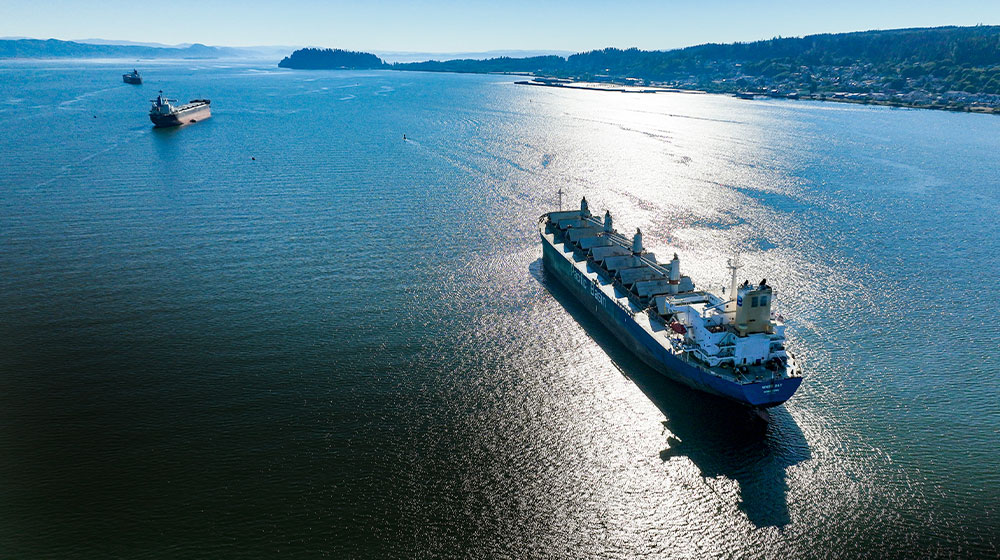The Panama and Suez canals are key shortcuts for cargo ships moving U.S. grain and ag products to global customers and bringing in fertilizer to feed crops.
Traffic through the Panama Canal has been restricted since mid-2023 by low water levels, while ships have avoided the Suez Canal since late 2023 due to geopolitical conflicts. The restrictions have forced many ships to take alternative routes, adding time and expense to each trip. U.S. growers, suppliers and end users are paying the price.
“Logistical challenges at the Panama and Suez canals make U.S. grain less competitive and add costs to the supply chain,” says Marion Le Bacquer, who oversees ocean freight at the CHS office in Geneva, Switzerland. The freight market is tighter, she adds, due to longer transit and turnaround times of cargo ships.
CHS typically books about 350 grain and fertilizer vessels each year, says Justin Cauley, senior director of transportation. Roughly 30% of those ships typically use the Panama Canal and 10% transit the Suez Canal.
Drought affects Panama Canal shipping
The Panama Canal connects the Atlantic and Pacific oceans. A system of locks raises ships from sea level to the level of Gatun Lake, which is used to fill the locks that allow ships to navigate the channel.
Panama Canal
- Year completed: 1914 (expanded in 2016)
- Ownership: Panama Canal Authority (Panama governmental agency)
- Length: 50 miles
- Typical transit time (excluding wait time): 8-10 hours
Source: Soy Transportation Coalition
Drought caused Gatun Lake levels to drop significantly in early 2023. Since the lake is also the primary fresh water source for Panama, the Panama Canal Authority was forced to restrict ship drafts and vessel volume starting in June 2023 to preserve water. Available slots through the canal are auctioned off to the highest bidder, which has increased transit rates.
Grain and oilseeds shipped from the Gulf of Mexico to buyers in Asia would normally go through the Panama Canal, but are being rerouted across the Atlantic Ocean through the Suez Canal or around the Cape of Good Hope on the southern tip of Africa, Cauley explains. For the 2022 fall shipping season, 85% of CHS grain shipments destined for Asia and originating from the U.S. Gulf passed through the Panama Canal, but only 15% used the shortcut during the same period in 2023.
“Most grain buyers would rather have a longer transit time versus paying the premium to go through the Panama Canal, but some buyers are willing to pay a premium to expedite cargo,” Cauley says.
Rerouting ships from the U.S. Gulf around the Cape of Good Hope adds about 30% more time and 30% more fuel. Every extra day at sea costs about $30,000, Cauley adds. “Grain and fertilizer markets have adjusted to reflect added shipping costs.”

Safety concerns cut Suez Canal traffic
The Suez Canal connects the Mediterranean Sea and Red Sea and is a key trade route between Europe and Asia. It’s also a shortcut for fertilizer shipments from the Arab Gulf to the U.S.
Suez Canal
- Year completed: 1869 (expanded in 2015)
- Ownership: Suez Canal Authority (Egypt governmental agency)
- Length: 120 miles
- Typical transit time (excluding wait time): 11-16 hours
Source: Soy Transportation Coalition
Shipping companies have avoided the Suez Canal and the Red Sea since Houthi rebels began attacking ships in November 2023 in response to the war in Gaza. Commerce is being rerouted around the Cape of Good Hope. The longer journey has increased ocean freight rates.
“Fertilizer shipped from Qatar and other Arab Gulf countries to the U.S. is more expensive as a result,” Cauley says.
Minimizing impact
The integrated CHS supply chain and logistics experts are helping to minimize the impact of canal shipping disruptions, says Neil Johnke, a corn trading expert with CHS. Some grain and oilseeds that would have been shipped from CHS export facilities in the U.S. Gulf were loaded out of facilities in the Pacific Northwest (PNW) to avoid using the Panama Canal.
“Our customers in Colombia and Costa Rica got the corn they needed and our customers in China got the sorghum and soybeans they needed. It kept grain moving,” Johnke says.
Ocean freighters need 15 to 20 days to sail from the PNW to China. It normally takes a ship leaving the U.S. Gulf Coast about 30 days to reach China when it transits the Panama Canal. It takes the same ship about 50 days to reach China sailing around the Cape of Good Hope.
For imported fertilizer, Cauley says planning is the key to meeting needs. CHS transportation experts continue to explore alternative shipping routes and logistics strategies to mitigate or off set cost increases related to canal limitations.
Check out the full Spring 2024 C magazine with this article and more.
Listen to an Around the Table episode on the canal crisis.




